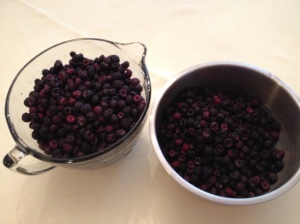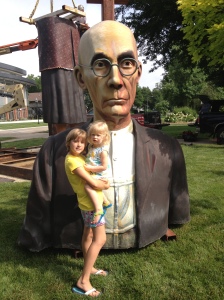A warm summer day, a picnic and much swimming. A couple days ago Wyatt, Jaiden and I headed to Lake Ahquabi State Park, about six miles south of Indianola. Kim and Elena also joined us for lunch and a little time in the water.
I used to tell our sons that I would consider them to be good spellers when they could spell “Ahquabi.” None of them ever took me up on the challenge, but Jaiden took me up on the challenge after I told her the story on our drive out. If she can’t spell it now (and she might be able to), I’ll bet she can the next time.
We found a picnic table under a tree near the beach and deposited our gear. Soon Kim and Elena arrived. They had been at the beach on the Gulf of Mexico only a week earlier. There Elena was afraid of the waves, so didn’t go into the water much; she mostly played in the sand on the beach. With no waves at the lake, she had no fear of the water. Kim or I stayed with her the entire time when she was in the water and we tried to emphasize the importance of not going into water over her knees. She loved the water.
Wyatt and Jaiden loved the water, also. When we go to the city pool, there are so many kids it is impossible to SWIM. Kids play, but can’t really do much swimming. I counted the people in the lake a couple times and reached numbers of 30 to 35 each time. At the lake, they were able to practice their swimming strokes. Both have had lessons; Wyatt just finished his second year a week ago. I was pleased with what I saw.
They also had sophisticated squirt guns (one is now residing somewhere in the lake) and they had brought some buckets and trowels. At one point they found a toad, named it Hoppy, and created a home for it in the sand with water and sea weed. (Thankfully, they released Hoppy back to the lake before we left instead of trying to bring it home.)
After lunch and after Kim and Elena left, I watched Jaiden and Wyatt from the shade of the tree. Farther out on the lake were several boaters, one person trolling his motor boat, some people with canoes, some stand-up paddle boaters, some 2-person paddle boats, and even some people with a pontoon boat criss-crossed the lake (from Wesley Woods, a Methodist Church camp on the other side of the lake).
I remember when the beach was covered with people. In the 1950s local and Des Moines newspaper headlines would extol the number of people who had been at the lake on a given summer Sunday, often many hundreds, even thousands. This is where my brother, sister and I took Red Cross swimming lessons with our friends. A school bus transported us to and from our lessons, each day for two weeks every summer.
Over the years I’ve enjoyed many picnics at the lake, and even stayed in some cabins for 4-H camp. Cabins have now been gone for many years.
In those days, the lake had ropes with buoys delineating the shallow water from the deeper water. We didn’t venture beyond the ropes unless we were confident of our swimming ability. There were two rafts in the shallower water and most of the time we would jump or dive off these rafts. There was one raft in the deeper water and further out a big tower with two diving boards, on opposite sides of the tower, one higher than the other. I never went off the highest board and probably only went off the lower one a couple times. I only remember two life guard stations, one at the ropes and one on the beach. I also remember the showers and changing rooms, and the locker baskets that held our valuables while we were swimming. In those days we had to pay to swim.
Everything changed as cities built municipal swimming pools.
Today swimming at the lake is free, but “at your own risk.” Today there are only a few buoys indicating to boaters that they should not enter the swimming area.
We arrived a little before 11 a.m. and left at 4 p.m. Afterwards I heard that Jaiden and Wyatt both slept well that night!

Jaiden & Wyatt – just to the right of center

Jaiden & Wyatt, and Hoppy perched on the little seaweed island on the left side of the pond
Read Full Post »








